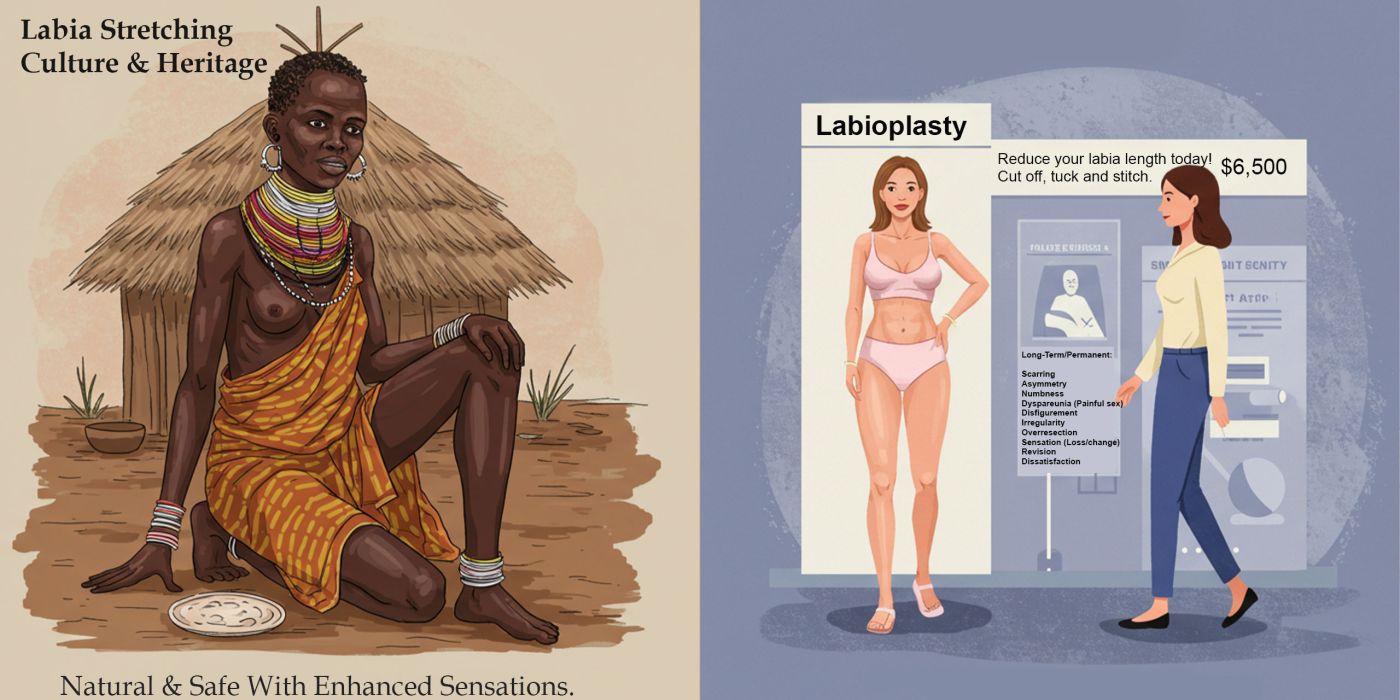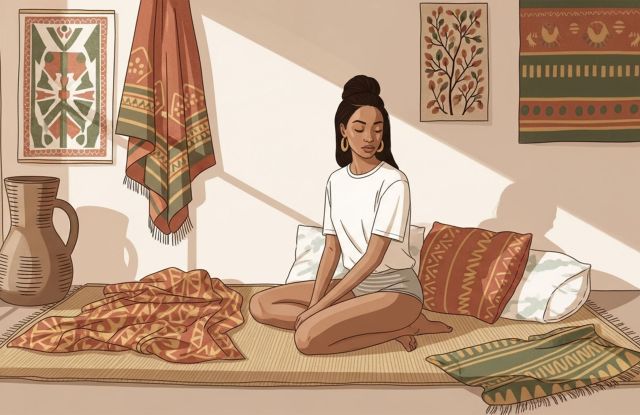
The Taboo of Labia Stretching: Exploring Social Stigmas and Why Some Reject It
Labia stretching, also known as labial elongation, is a body modification practice with deep cultural roots in parts of Africa and among diasporic communities worldwide. For some women, it carries personal, cultural, or even spiritual significance, while for others it represents an intimate form of self-expression or sexual enhancement. Yet despite its long history and meaning, labia stretching is often surrounded by controversy, stigma, and misunderstanding, particularly in societies where it is unfamiliar.
Much of this taboo stems from misinformation, cultural differences, and discomfort around women’s sexuality, leading to dismissive or even hostile attitudes. Understanding why labia stretching is stigmatized requires a closer look at the social forces shaping perceptions of women’s bodies.
What Makes Labia Stretching Taboo?
The word “taboo” refers to something that society views as forbidden, shameful, or off-limits. Labia stretching has acquired this status in many communities for a range of reasons:
1. Lack of Awareness and Understanding
Most people outside the cultures where labia stretching is practiced know little about its origins, techniques, or significance. This absence of knowledge fuels misconceptions, often leading to its dismissal as strange or unnecessary. Some mistakenly equate it with female genital mutilation (FGM), despite the crucial distinction that labia stretching is voluntary, non-destructive, and not about cutting or removal. Without education, people default to judgment rather than empathy.
2. Cultural Differences
Practices that are celebrated in one culture can be condemned in another. In the West, labia stretching is often framed as exotic or foreign, creating a sense of cultural distance. Viewed through an ethnocentric lens, the practice becomes "unnatural" or "harmful," not because it truly is, but because it does not align with Western beauty norms or sexual values. This culture clash helps sustain its taboo status.
3. Sexuality and Body Image Taboos
Across much of the world, women’s bodies—particularly their genitalia—are surrounded by layers of silence, shame, and control. Female sexuality remains one of the most heavily policed aspects of identity. Modifications involving the genitals, even when chosen freely, trigger discomfort because they symbolize autonomy over sexual identity. For societies that struggle with women owning their sexuality, labia stretching becomes doubly taboo: it is both visible (in its physical outcome) and symbolic (in its assertion of agency).
4. Association with “Exotic” or “Primitive” Practices
Labia stretching has historically been tied to African cultural traditions. Unfortunately, colonial mindsets and lingering ethnocentrism often brand such practices as “backward” or “primitive.” Instead of being understood within their cultural framework, they are judged through Western ideals. This bias reduces a meaningful practice to a stereotype and fuels rejection based on prejudice rather than understanding.
Why Do Some People Reject Labia Stretching?
Rejection of labia stretching arises from a mix of fears, cultural norms, and ideological positions:
1. Fear of Harm or Misconceptions
The most common objection is the belief that labia stretching could cause physical damage. This is often due to confusion with FGM, which is non-consensual and medically harmful. In contrast, labia stretching is gentle, gradual, and consensual. Yet the persistence of misinformation continues to cloud public perception, creating a climate of fear rather than informed choice. In stark contrast, labioplasty has caused massive damage to a segment of the female population, resulting in loss of sensation, disfigured genitals, and chronic pain. Why, then, is an ancient tradition considered harmful, while a Western one that has destroyed lives is widely accepted?
2. Body Image Standards
Global beauty ideals dictate that “desirable” female genitalia should appear small, neat, and uniform. These narrow standards have been reinforced by media, pornography, and cosmetic surgery trends like labiaplasty. Women with naturally elongated labia—or those who practice stretching—may feel ashamed or judged for looking different. When beauty norms are rigid, any deviation from them, including labia stretching, is stigmatized.
3. Feminist Debates on Sexual Autonomy
Within feminism, labia stretching sparks divided and hate-inspired opinions. Some feminists argue that it reinforces patriarchal expectations if practiced to satisfy male pleasure, framing it as another way women’s bodies are shaped for men. In this way, some critics argue, it is an act of women imposing on other women's freedom. Others, however, counter that policing women’s choices—whether to stretch, pierce, tattoo, or not—is itself a denial of autonomy. For them, true empowerment lies in supporting women’s freedom to decide what feels right for their own bodies, regardless of external judgments.
4. Lack of Personal Relevance
For individuals without cultural or personal ties to labia stretching, the practice may seem alien or irrelevant. Without context, it can appear unnecessary, making rejection easier than curiosity. This indifference stems less from hostility and more from a lack of connection or education about its meaning.
Common Misconceptions vs. Realities of Labia Stretching
| Misconception | Reality |
|---|---|
| It’s the same as FGM | Labia stretching is voluntary and does not involve cutting or removal. |
| It causes harm | When practiced gradually, it is not medically harmful and can be safe. |
| Only “primitive” cultures do it | It is a meaningful tradition in some African communities and also practiced by women worldwide today. |
Breaking the Taboo: Why Dialogue Matters
Key Insight: Labia stretching is not about harm—it’s about cultural identity, personal choice, and body autonomy. Respecting these differences is essential to breaking the stigma.
The taboo surrounding labia stretching persists largely because of silence and stigma. To challenge these misconceptions, society needs open, respectful conversations that acknowledge cultural diversity and the right to bodily autonomy.
-
Education can dispel myths and separate labia stretching from harmful practices like FGM.
-
Representation of diverse genital appearances can reduce the shame caused by narrow beauty ideals.
-
Dialogue within feminist spaces can move beyond prescriptive rules, centering women’s freedom to choose for themselves.
Ultimately, labia stretching is neither universally empowering nor universally oppressive—it is a personal, cultural, and bodily decision. Like tattoos, piercings, or other modifications, its meaning depends on context and intention.
Did You Know?
Anthropological studies show that labia stretching has been practiced for centuries in parts of Africa, not only for intimacy but also as a rite of passage symbolizing maturity and womanhood.
Conclusion
Labia stretching remains taboo not because it is inherently harmful, but because it sits at the crossroads of cultural misunderstanding, restrictive beauty standards, and societal discomfort with women’s sexuality. By encouraging awareness, dismantling prejudice, and respecting women’s choices, this intimate practice can be reframed not as shameful, but as a valid form of cultural expression and personal autonomy.
In moving beyond stigma, we create space for women to define their bodies on their own terms—without fear, judgment, or imposed narratives.
Frequently Asked Questions
Q: Is labia stretching harmful?
A: No. When done gradually and voluntarily, it is not harmful and differs from practices like FGM.
Q: Why is labia stretching considered taboo?
A: It is stigmatized due to cultural misunderstandings, beauty standards, and discomfort with women’s sexuality.
Q: Do all women practice labia stretching?
A: No. It is culturally significant in some regions, but many women choose it for personal, aesthetic, or intimate reasons.
Q: Is labia stretching only done to please men?
A: Not necessarily. While some critics frame it that way based mostly on ignorance, many women choose it for reasons such as personal empowerment, tradition, enhanced sexual pleasure, or comfort. It is, ultimately, a matter of individual agency.







